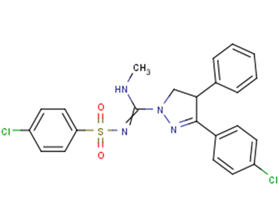
SLV319
CAS No. 362519-49-1
SLV319( (±)-SLV319 | (±)-BMS6462 )
Catalog No. M18476 CAS No. 362519-49-1
SLV319 has been used in trials studying the treatment of Obesity and Obesity and Type 2 Diabetes.
Purity : >98% (HPLC)
 COA
COA
 Datasheet
Datasheet
 HNMR
HNMR
 HPLC
HPLC
 MSDS
MSDS
 Handing Instructions
Handing Instructions
| Size | Price / USD | Stock | Quantity |
| 2MG | 40 | In Stock |


|
| 5MG | 65 | In Stock |


|
| 10MG | 125 | In Stock |


|
| 25MG | 250 | In Stock |


|
| 50MG | 462 | In Stock |


|
| 100MG | 669 | In Stock |


|
| 500MG | 1341 | In Stock |


|
| 1G | Get Quote | In Stock |


|
Biological Information
-
Product NameSLV319
-
NoteResearch use only, not for human use.
-
Brief DescriptionSLV319 has been used in trials studying the treatment of Obesity and Obesity and Type 2 Diabetes.
-
DescriptionSLV319 has been used in trials studying the treatment of Obesity and Obesity and Type 2 Diabetes.(In Vitro):Cannabinoid receptor 1 (CB1R) antagonists appear to be promising drugs for the treatment of obesity, however, serious side effects have hampered their clinical application. Ibipinabant is a new, potent [Ki (CB1)=7.8 nM] and selective [Ki (CB2)=7.943 nM] CB1 antagonist [pA2 for arachidonic acid release in CHO cells=9.9] with in vitro pharmacological characteristics similar to rimonabant including inverse agonism and brain penetrance.(In Vivo):(±)-Ibipinabant ((±)-SLV319) (3 mg/kg) reduces unfasted glucose to a significantly greater degree than rimonabant at the same dose on days 17, 28 and 38. Chronic treatment with (±)-Ibipinabant ((±)-SLV319) significantly attenuates the progression of diabetes in ZDF rats, blunting the increase in blood glucose and HbA1c over time. Ibipinabant also reduces the hyperinsulinemia apparent at 6-8 weeks of age and attenuates the dramatic reduction in insulin levels observed 1-2 weeks later.
-
In VitroCannabinoid receptor 1 (CB1R) antagonists appear to be promising drugs for the treatment of obesity, however, serious side effects have hampered their clinical application. Ibipinabant is a new, potent [Ki (CB1)=7.8 nM] and selective [Ki (CB2)=7.943 nM] CB1 antagonist [pA2 for arachidonic acid release in CHO cells=9.9] with in vitro pharmacological characteristics similar to rimonabant including inverse agonism and brain penetrance.
-
In Vivo(±)-Ibipinabant ((±)-SLV319) (3 mg/kg) reduces unfasted glucose to a significantly greater degree than rimonabant at the same dose on days 17, 28 and 38. Chronic treatment with (±)-Ibipinabant ((±)-SLV319) significantly attenuates the progression of diabetes in ZDF rats, blunting the increase in blood glucose and HbA1c over time. Ibipinabant also reduces the hyperinsulinemia apparent at 6-8 weeks of age and attenuates the dramatic reduction in insulin levels observed 1-2 weeks later.
-
Synonyms(±)-SLV319 | (±)-BMS6462
-
PathwayOthers
-
TargetOther Targets
-
RecptorCB1
-
Research Area——
-
Indication——
Chemical Information
-
CAS Number362519-49-1
-
Formula Weight487.4
-
Molecular FormulaC23H20Cl2N4O2S
-
Purity>98% (HPLC)
-
SolubilityDMSO : ≥ 31 mg/mL; 63.60 mM
-
SMILESO=S(=O)(N=C(NC)N1CC(C(=N1)c2ccc(Cl)cc2)c3ccccc3)c4ccc(Cl)cc4
-
Chemical Name——
Shipping & Storage Information
-
Storage(-20℃)
-
ShippingWith Ice Pack
-
Stability≥ 2 years
Reference



-
Potassium antimonyl ...
Antimony potassium tartrate also known as potassium antimonyl tartrate potassium antimontarterate or emetic tartar has the formula K2Sb2(C4H2O6)2 and is the double salt of potassium and antimony of tartaric acid.
-
8-Hydroxy-5,7-dimeth...
8-Hydroxy-5,7-dimethoxyflavanone represents a useful tumor-preventive phytochemical that triggers p53-driven G2/M cell cycle arrest and apoptosis.PDMF(8-Hydroxy-5,7-dimethoxyflavanone) as a new potent anti-allergic phytochemical useful for prevention of IgE-driven hypersensitivity reactions.8-hydroxy-5,7-dimethoxyflavanone has anti-inflammatory activity.
-
Dihydroartemisinin
Dihydroartemisinin (DHA) is a semi-synthetic derivative of artemisinin and isolated from the traditional Chinese herb Artemisia annua.



 Cart
Cart
 sales@molnova.com
sales@molnova.com


